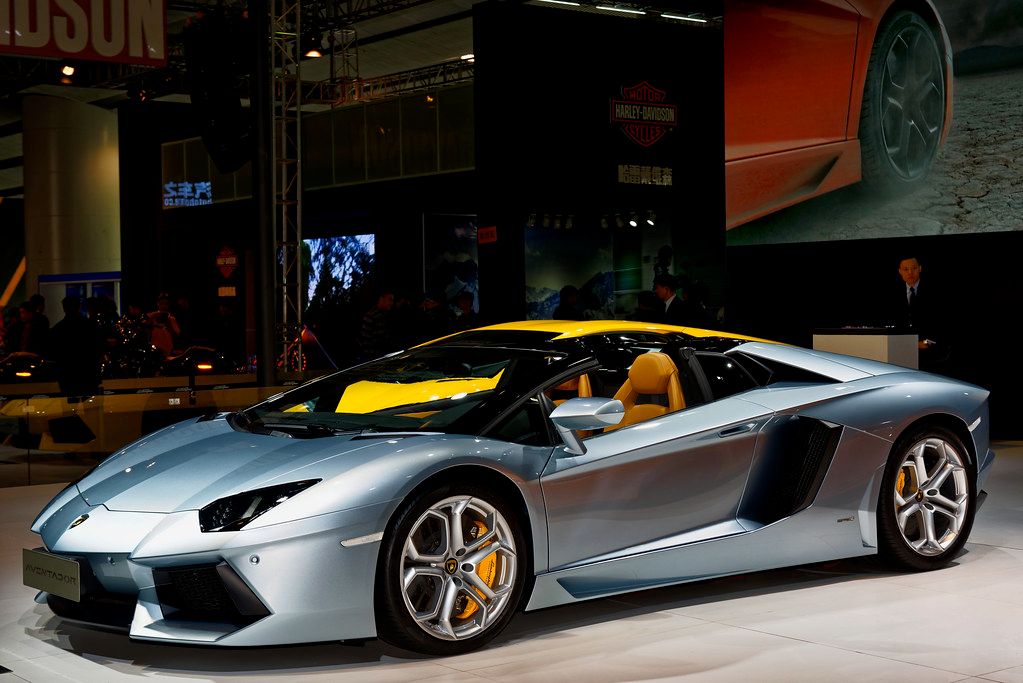
Alright, fellow gearheads and casual car admirers, buckle up! You know how it is – the automotive world moves at a breakneck speed, churning out new models, reinventing classics, and sometimes, just sometimes, leaving behind some truly incredible machines in its wake. We’re talking about those unsung heroes, the cars that didn’t get the spotlight they deserved, whether it was due to poor marketing, being a bit too far ahead of their time, or just getting overshadowed by louder, flashier rivals.
But let me tell you, just because time and public perception might have moved on doesn’t mean these beauties aren’t still utterly fantastic. In fact, many of them are engineering marvels, some are performance beasts hiding in plain sight, and others were simply misunderstood. We’re on a mission today to shine a bright, glorious light on these truly awesome cars that time and the public mostly forgot. And trust me, you’ll be kicking yourself for not noticing them sooner!
For over a decade, the interest in classic, muscle, and even ’80s and ’90s models has been absolutely peaking, driving up prices for the usual suspects. But there’s a whole world of forgotten, overlooked models that have flown under the collector’s radar, offering you a chance to grab an interesting, cool-looking classic without breaking the bank. So, before their values inevitably climb, let’s take a look at some of these relatively inexpensive, yet undeniably cool, forgotten rides that are still within reach of the average classic car collector’s budget.
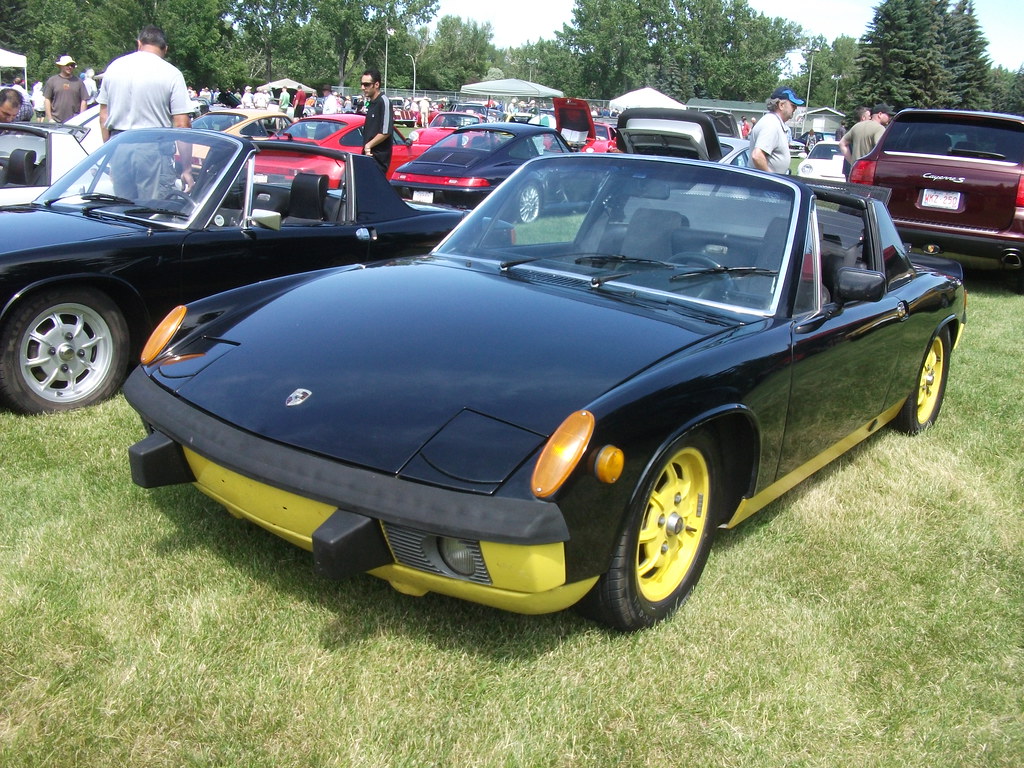
1. **Porsche 914**When we talk about classic Porsches, most people immediately think of the iconic 911. And yes, the 911 is currently one of the most sought-after classic cars on the market, with prices for decent models nearing $50,000 and rare racing models hitting a million dollars. It’s fashionable to own a classic 911, and the prices definitely reflect that, even though those early cars can be rust-prone, uncomfortable, and not exactly speed demons by modern standards.
But what if I told you there’s another way to own a classic Porsche, complete with a centrally-mounted engine, lively performance, and a cool Targa top, all for around $15,000? Enter the Porsche 914. Offered from 1969 to 1976 as an entry-level model, the 914 was a collaboration between Porsche and Volkswagen, sometimes even earning it the moniker ‘VW-Porsche 914’.
Don’t let the ‘entry-level’ tag fool you, though. Behind the driver sits a Volkswagen-derived flat-four engine, typically churning out around 100 HP. Now, 100 HP might not sound like much on paper, but this car is an absolute featherweight, tipping the scales at approximately 1,980 pounds. That lightweight construction ensures that the performance is, in fact, incredibly lively, making for a truly engaging driving experience.
What truly sets the 914 apart is its perfect weight distribution. This engineering marvel guarantees superb road handling, making it a joy to drive through winding roads and spirited corners. And for the real enthusiasts, Porsche even produced a rare 914-6 model, boasting 110 HP from a flat-six engine. Over its seven-year production run, more than 118,000 914s were built, with the vast majority sold right here in the U.S., meaning there are plenty of affordable options out there just waiting to be discovered. It’s a genuine classic Porsche experience without the sky-high 911 price tag!
Car Model Information: 1970 Porsche 914 914/6
Name: Porsche 914
Caption: 1970 Porsche 914
Manufacturer: Porsche,Karmann
Aka: VW-Porsche 914
Production: 1969–1976,118,978 produced,914/4: 115,646,914/6: 3,332,914/8: 2
Assembly: Stuttgart,Osnabrück
Predecessor: Porsche 912,Volkswagen Karmann Ghia#Type 34 Karmann Ghia
Successor: Porsche 924
Class: Sports car
BodyStyle: Targa top
Layout: Rear mid-engine, rear-wheel-drive layout
Engine: Volkswagen air-cooled engine#Type 4: 1.7–2.0 litres,Volkswagen air-cooled engine#Type 4: 1.7–2.0 litres,Volkswagen air-cooled engine#Type 4: 1.7–2.0 litres,Porsche flat-six engine
Wheelbase: cvt
Length: cvt
Width: cvt
Height: cvt
Weight: cvt
Related: Porsche 914-6 GT,Porsche Tapiro
Designer: Ferdinand Alexander Porsche
Categories: 1970s cars, 24 Hours of Le Mans race cars, All articles needing additional references, All articles with incomplete citations, All articles with unsourced statements
Summary: The Porsche 914 or VW-Porsche 914 is a mid-engined sports car designed, manufactured and marketed collaboratively by Volkswagen and Porsche from 1969 until 1976. It was available only as a targa-topped two-seat roadster powered by either a flat-4 or flat-six engine.
Get more information about: Porsche 914
Buying a high-performing used car >>>
Brand: Porsche Model: 914
Price: Not Priced Mileage: 52,111 mi.
Read more about: 11 SUVs That Promise Adventure But Deliver Owners Immediate Regret

2. **Volvo 480 Turbo**In the era of radical wedge-shaped cars from the ’70s and ’80s, Volvo, known for its sensible and safe vehicles, decided to join the party – albeit fashionably late. In 1986, they unleashed the Volvo 480, and it was quite a statement. This wasn’t just any Volvo; it was the brand’s first-ever front-wheel-drive car, featuring a transverse-mounted four-cylinder engine under its hood. And get this: it had uber-cool pop-up headlights! Seriously, pop-up headlights on a Volvo? Pure retro gold.
The 480 Turbo was designed with a sleek, sporty aesthetic that was a radical departure for the Swedish automaker. Its unique styling and pioneering front-wheel-drive layout marked Volvo’s foray into a more dynamic and youth-oriented market segment. The turbocharged variant promised a peppy performance, a delightful surprise for those accustomed to Volvo’s more sedate offerings.
Despite its innovative features and fresh design, the late ‘80s were a fiercely competitive time for hot hatches. The market was absolutely saturated with fantastic options from various manufacturers, each vying for the attention of performance-oriented drivers. Unfortunately for the Volvo 480, it simply couldn’t keep up with the overwhelming competition.
Surrounded by an army of established hot hatch champions, the 480, despite its charms, quickly faded into obscurity. It never quite achieved the mainstream recognition it probably deserved. Yet, for those in the know, the Volvo 480 Turbo remains a fascinating piece of automotive history, a quirky, stylish, and surprisingly spirited machine that represents a bold, if ultimately understated, chapter in Volvo’s evolution.
Read more about: Beyond the Luster: 15 Luxury Cars That Dazzle Visually But Disappoint Behind the Wheel, According to Owners and Experts
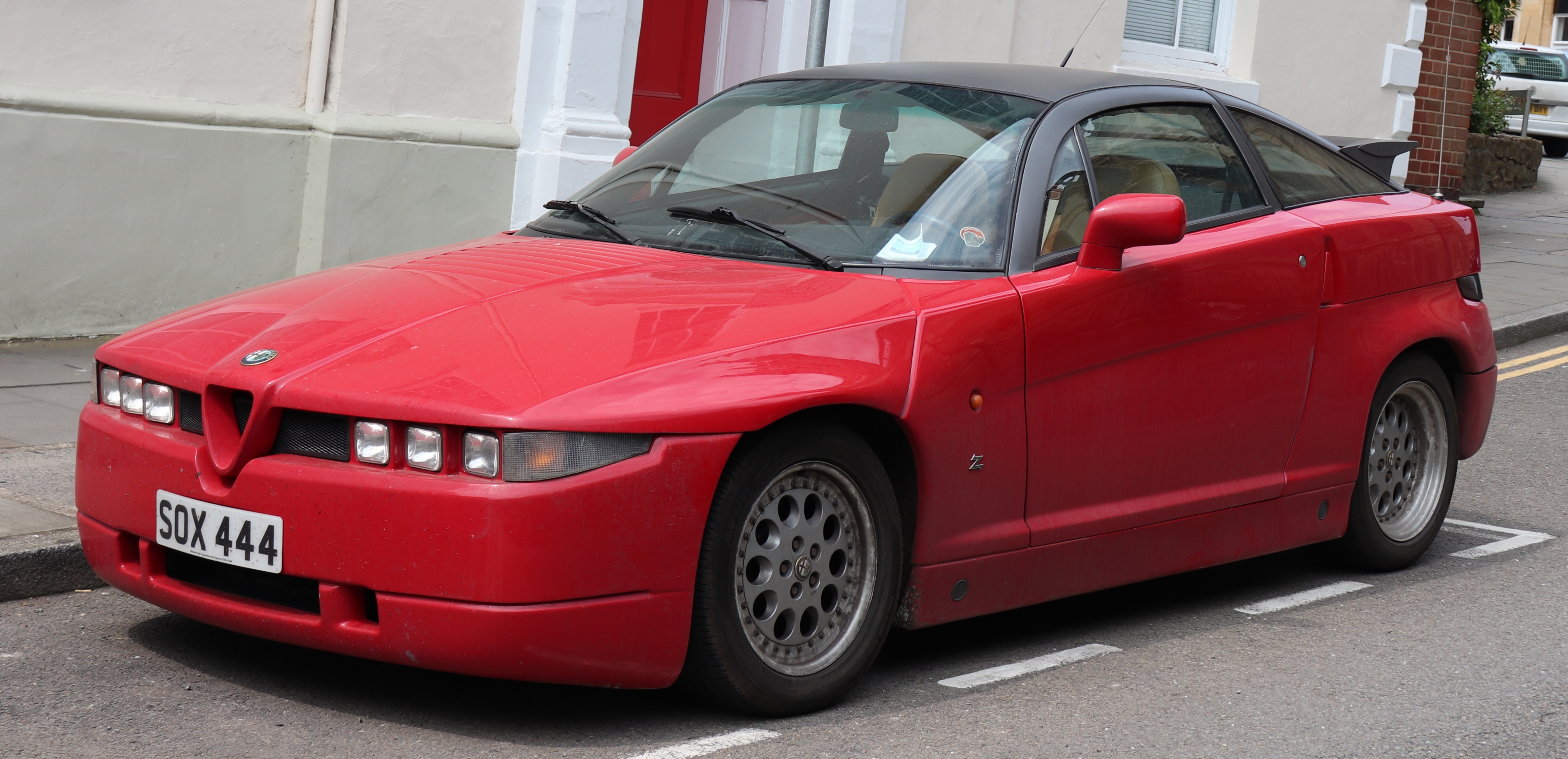
3. **Alfa Romeo SZ**Oh, Alfa Romeo. The name alone conjures images of passionate driving and breathtaking Italian design. And then there’s the Alfa Romeo SZ, a car that will forever hold a special place in the pantheon of jaw-dropping classic Italian sports cars. This striking machine made quite an impact in the late ‘80s, and it was no ordinary production car; it was a masterpiece designed by the legendary coachbuilder Zagato and meticulously handbuilt in Milan.
The SZ, with its incredibly distinctive and aggressive angular lines, was affectionately nicknamed ‘Il Monstro’ – ‘The Monster’ – by the automotive press, and for good reason. Its design was radical, polarizing, and utterly unforgettable, boasting a geometric, almost brutalist aesthetic that challenged conventional notions of beauty in sports car design. Every panel screamed performance and a fearless approach to styling.
Underneath that provocative bodywork lay a robust 3.0-liter ‘Busso’ V6 engine, renowned for its glorious sound and smooth power delivery, providing performance that matched its fierce looks. It was a proper driver’s car, delivering an unadulterated, visceral experience that truly connected the driver to the road. The SZ wasn’t just a car; it was a statement.
However, the SZ’s striking appearance wasn’t to everyone’s taste. Its bold, uncompromising design meant it wasn’t universally loved, and its appeal was somewhat niche. Furthermore, with just around 1,000 examples ever built, according to Stellantis Heritage, this car was always destined for rarity. As a result, the SZ remains a true cult icon, cherished primarily by hardcore Alfistis who appreciate its unique blend of artistry, engineering, and sheer audacity. It’s a testament to Alfa Romeo’s willingness to push boundaries, even if it meant alienating some in the process.
Car Model Information: 2022 Honda Civic Sport
Caption: Alfa Romeo SZ
Name: Alfa Romeo SZ,Alfa Romeo RZ
Manufacturer: Alfa Romeo
Aka: ES-30 (internal codename),Il Mostro
Production: 1989–1991 (SZ),1992–1994 (RZ)
Assembly: Rho (Italy)
Class: Sports car
BodyStyle: coupé,convertible
Layout: Front-engine, rear-wheel-drive layout
Powerout: cvt
Engine: cvt,Alfa Romeo V6 engine#3.0
Transmission: Manual transmission
Wheelbase: cvt
Length: cvt
Width: cvt
Height: {{cvt,1310,mm,in,1
Weight: {{cvt,1260,kg,lb,0
Related: Alfa Romeo 75
Designer: Centro Stile Fiat:,Robert Opron,Antonio Castellana
Categories: 1990s cars, Alfa Romeo vehicles, All articles needing additional references, Articles needing additional references from November 2024, Articles with short description
Summary: The Alfa Romeo SZ (for Sprint Zagato) and codenamed ES-30 for Experimental Sportscar 3.0 litre, is a high-performance limited-production sports car built from 1989 to 1991 by a partnership between Centro Stile Zagato, Centro Stile Alfa Romeo and Centro Stile Fiat. It was unveiled as the ES-30 at the 1989 Geneva Motor Show as a prototype by Zagato with the styling house assigned the responsibility of assembling the car.
Get more information about: Alfa Romeo SZ
Buying a high-performing used car >>>
Brand: Alfa Romeo Model: SZ
Price: $25,849 Mileage: 16,061 mi.
Read more about: Beyond the Luster: 15 Luxury Cars That Dazzle Visually But Disappoint Behind the Wheel, According to Owners and Experts
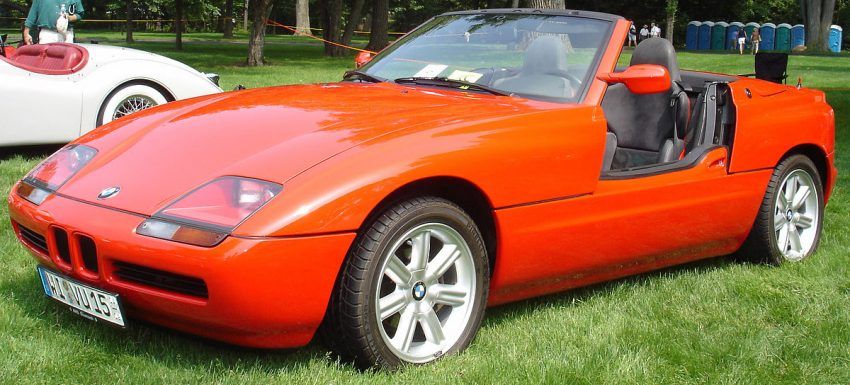
4. **BMW Z1**BMW has given us some incredible ‘Z’ cars over the years, but arguably the most groundbreaking and, perhaps, the most ‘forgotten’ of them all is the Z1. Unveiled in 1989, the Z1 was BMW’s very first ‘Z’ car, and it redefined what a roadster could be. In true topless sports car fashion, it featured a rear-wheel-drive layout, a manual transmission, and a retractable canvas roof – the familiar ingredients for open-air driving pleasure.
But that, my friends, is where conventionality for the Z1 abruptly ends. This car was a marvel of innovation, pushing boundaries in ways few production vehicles dared. Its standout features were nothing short of revolutionary: vertical sliding doors that literally vanished into its body, creating an unparalleled open-cockpit feel, and body panels that could be easily swapped if you fancied a different color. Imagine changing your car’s outfit as easily as your own! This level of modularity was practically unheard of.
The Z1 wasn’t just about party tricks; it was built on a unique platform with a monocoque chassis that featured a steel frame and composite panels, contributing to its rigidity and distinctive character. Power came from a 2.5-liter inline-six engine, offering a spirited performance that perfectly complemented its agile handling and lightweight construction. It was designed to be a driver’s car, engaging and exciting on every twist and turn.
Due to its experimental nature and complex manufacturing process, BMW only made a limited run of 8,000 examples of the Z1. This extreme rarity means that the chances of spotting one of these pretty and profoundly unique BMWs out in the wild are incredibly slim. It remains a fascinating footnote in BMW’s history, a car that truly dared to be different and, in doing so, became a legend for those who appreciate true automotive innovation.
Read more about: The Ultimate Nineties Rewind: 15 Coolest Cars of the Decade That Still Fuel Our Automotive Dreams
5. **Mitsubishi Pajero Mini**Here’s a fun fact for you: kei cars are, as MotorTrend describes, “the smallest street-legal passenger cars, vans, and trucks that you can buy in Japan.” And speaking from personal experience, everyone absolutely loves kei cars! Their adorable, compact proportions and surprisingly clever engineering make them endlessly endearing. The catch? Because they were almost exclusively sold in Japan, many car enthusiasts around the world often forget they even exist.
Enter the Mitsubishi Pajero Mini, essentially a bite-sized, incredibly charming version of the much larger and more rugged Mitsubishi Pajero. At first glance, its cutesy appearance might lead you to believe it’s just a city dweller, a charming urban runabout. But oh, how looks can be deceiving! Don’t let its adorable facade fool you; this little dynamo is just as capable as its full-size variant when it comes to tackling rough terrain.
Underneath that compact exterior lies a seriously impressive driveline that allows you to choose between two- and four-wheel drive, along with other essential off-road goodies. This means the Pajero Mini is not just for grocery runs; it’s a legitimate miniature off-roader, ready to tackle trails and navigate challenging landscapes with surprising ease. It embodies the spirit of adventure in a package that fits almost anywhere.
Designed to maximize interior space within Japan’s strict kei car regulations, the Pajero Mini offered a practical yet fun solution for those needing a versatile vehicle. Its small engine displacement, typically a 660cc unit, kept running costs down, making it an economical choice for Japanese buyers. But for us, it’s a fascinating example of how capability can come in the most unexpected and utterly delightful packages, a truly forgotten gem that deserves a massive shout-out!
Car Model Information: 2022 Honda Civic Sport
Name: Mitsubishi Pajero Mini
Manufacturer: Mitsubishi Motors
Aka: Nissan Kix
Production: 1994–2012
Assembly: Kurashiki, Okayama
Class: Kei car
BodyStyle: SUV
Layout: unbulleted list
Successor: Mitsubishi eK#fourth
Categories: 2000s cars, All-wheel-drive vehicles, Articles containing Japanese-language text, Articles with short description, CS1 Japanese-language sources (ja)
Summary: The Mitsubishi Pajero Mini (Japanese: 三菱・パジェロミニ, Hepburn: Mitsubishi Pajero Mini) is a kei car produced by Mitsubishi Motors from December 1994 until June 2012.
Get more information about: Mitsubishi Pajero Mini
Buying a high-performing used car >>>
Brand: Mitsubishi Model: Pajero Mini
Price: $25,849 Mileage: 16,061 mi.
Read more about: Is Your Ride a Ticking Time Bomb? 14 Popular Cars That Can Seriously Let You Down After 100K Miles
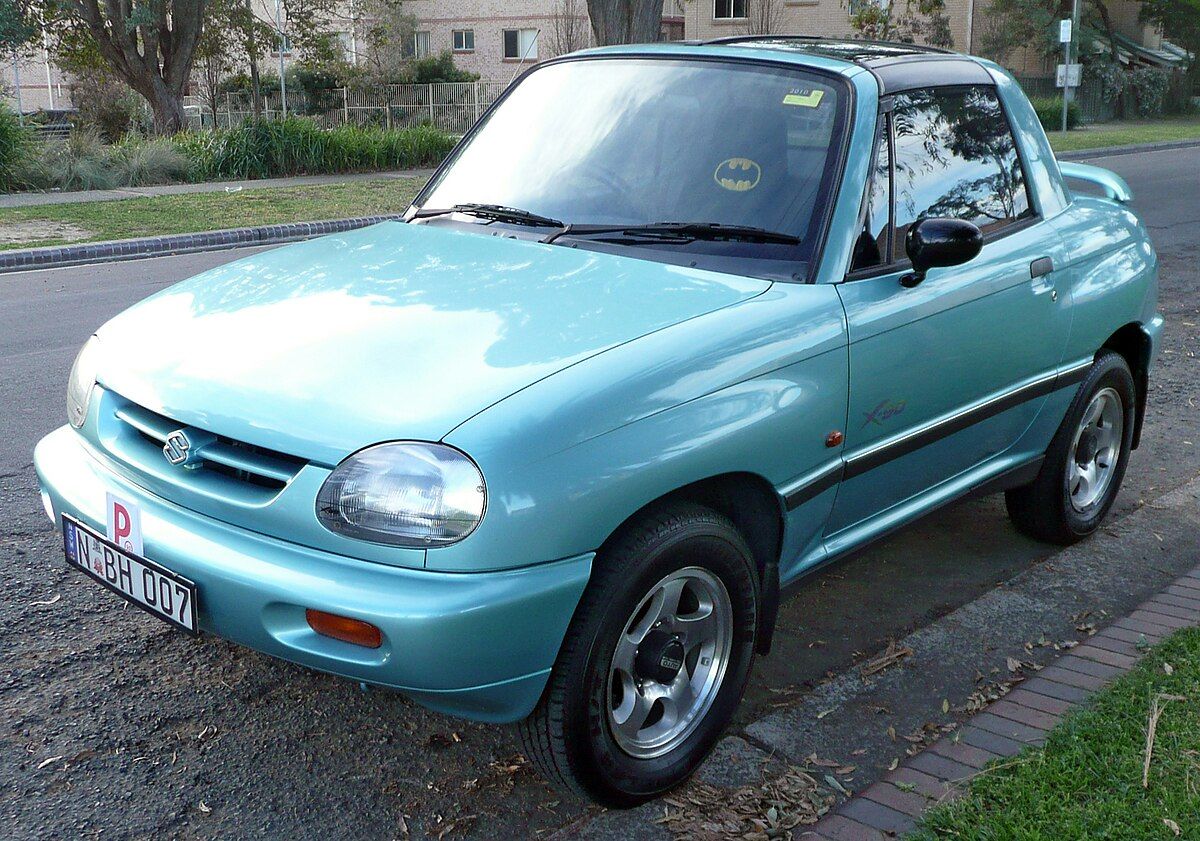
6. **Suzuki X-90**Now, here’s a car that truly broke the mold, though perhaps not in the way its creators intended: the Suzuki X-90. Suzuki boldly declared it to be “the world’s first two-seater SUV coupe.” And if you ask me, that very description hints at why the X-90 wasn’t exactly a smash hit with the crowds. It suffered from what one might call a deliciously conflicted target audience, a beautiful paradox on wheels.
On one hand, the X-90 was genuinely an off-road-capable SUV. It came equipped with a proper four-wheel-drive system and even low-range gearing, meaning it was ready and willing to tackle some serious trails and rugged terrain. It had the hardware to back up its SUV credentials, promising adventure and outdoor escapades for the intrepid driver. This was no mere pretender to the off-road throne; it was the real deal.
But then, on the other hand, there was its undeniable aesthetic. It looked, to put it affectionately, like a cute little gerbil on wheels. Its compact, almost cartoonish proportions and quirky styling simply didn’t align with the rugged, serious image that many traditional cross-country enthusiasts associated with off-road vehicles. The visual message and the mechanical capability were at odds, creating a car that confused as much as it intrigued.
Despite this identity crisis, and perhaps because of it, the Suzuki X-90 is still an awesome piece of machinery in its own right. Its unique blend of compact size, two-seater sportiness, and genuine off-road prowess makes it a truly distinctive vehicle that dared to forge its own path. It’s a reminder that sometimes the most interesting cars are the ones that defy easy categorization, a truly forgotten cult classic waiting for its moment to shine again.
Car Model Information: 1996 Suzuki X-90 4WD
Name: Suzuki X-90
Manufacturer: Suzuki
Aka: Suzuki Vitara X-90 (Europe)
Production: 1995–1997
Assembly: Iwata, Shizuoka
Class: Subcompact car
BodyStyle: coupe
Layout: Front-engine, rear-wheel-drive layout,Front-engine, four-wheel-drive layout
Chassis: Body-on-frame
Engine: SOHC,Suzuki G engine#G16A
Transmission: Automatic transmission,Manual transmission
Wheelbase: 2200 mm
Abbr: on
Length: 3710 mm
Width: 1695 mm
Height: 1550 mm
Weight: 1100 kg
Related: Suzuki Vitara
Predecessor: Suzuki Jimny#Second generation (1981)
Categories: All-wheel-drive vehicles, All articles with unsourced statements, Articles with short description, Articles with unsourced statements from August 2018, Cars introduced in 1995
Summary: The Suzuki X-90 is a front engine, rear or four wheel drive, two door, two seater car manufactured and marketed by Suzuki for the model years 1995-1997. Derived from the Suzuki Vitara, the X-90 featured a T Section removable roof. Replacing the Samurai in the market in the United States, Suzuki began marketing the X-90 in Japan by the end of 1995, and in western markets in April 1996.
Get more information about: Suzuki X-90
Buying a high-performing used car >>>
Brand: Suzuki Model: X-90
Price: $5,000 Mileage: 146,943 mi.
Read more about: Buyer’s Remorse: 15 Cars Drivers Wished They Never Bought

7. **Isuzu VehiCross**Usually, the quirkier a car, the more people talk about it, right? It becomes an instant conversation starter, a head-turner, a legend in its own time. Yet, after more than 25 years since its introduction, it feels like no one seems to drool over the Isuzu VehiCross like they once did. And that, my friends, is a crying shame, because this vehicle was, and still is, a marvel of unconventional design and serious capability.
MotorTrend famously described the VehiCross as “the sport/ute equivalent of a cross-trainer shoe.” And honestly, I couldn’t have said it better myself. That comparison perfectly encapsulates its dual nature: a vehicle that was rugged and ready for adventure, yet also possessed a stylish, almost futuristic flair that made it stand out from the sea of more traditional SUVs. It was designed to do a bit of everything, and look utterly unique doing it.
Its utilitarian design wasn’t just for show; it was genuinely functional, boasting a compact footprint for maneuverability and unique cladding that was both aesthetic and protective. The host of purposeful drivetrain upgrades included a capable four-wheel-drive system with a torque-on-demand transfer case, ensuring it was more than ready for challenging off-road conditions. It was a vehicle engineered for exploration, a true workhorse cloaked in avant-garde styling.
The VehiCross was powered by a 3.5-liter V6 engine, providing ample power for both highway cruising and off-road excursions. Its short wheelbase and independent front suspension, combined with a four-link rear suspension, gave it surprisingly good on-road manners while maintaining impressive articulation off-road. It was a bold experiment in SUV design and engineering, proving that practicality and distinctive style don’t have to be mutually exclusive. This forgotten gem absolutely deserves renewed admiration for its audacious spirit and undeniable capabilities.
Read more about: Automotive Hall of Shame: 16 Truly Ugly Cars

8. **Alfa Romeo 145 Cloverleaf**Alright, my fellow car fanatics, let’s talk about a car that even the most dedicated Alfisti might have, dare I say, almost *forgotten* about! Yes, even as an admitted Alfa Romeo fanboy, I’m ashamed to admit the 145 Cloverleaf nearly slipped my mind. This hot hatch from the ’90s packed a punch that deserved far more attention than it got.
According to Parkers, this little Italian firecracker could rocket from 0 to 60 mph in a swift 8 seconds. While that might not set any modern-day speed records, especially compared to today’s blistering hot hatches, it was definitely zippy for its era. It delivered a truly engaging driving experience, a hallmark of Alfa Romeo’s spirit.
What truly made the 145 Cloverleaf stand out was its absolutely flamboyant design! Picture this: the ’90s were a time of bold choices, and this Alfa embraced that wholeheartedly. Its distinctive styling, with those sharp lines and unmistakable Alfa grille, was a breath of fresh air amidst its more subdued competitors. It screamed personality, making every journey an event.
Unfortunately, despite its spirited performance and undeniable flair, the 145 Cloverleaf found itself in a crowded playground. The ’90s were overflowing with an army of other fun-to-drive cars, and this plucky Alfa, sadly, got overshadowed. It’s a real shame, because it offered such a unique blend of Italian passion and everyday usability. For those who appreciate its charm, it’s a beautiful, forgotten gem.
Car Model Information: 2022 Honda Civic Sport
Name: Alfa Romeo 145,Alfa Romeo 146
Caption: Alfa Romeo 145 Quadrifoglio
Manufacturer: Alfa Romeo
Production: Unbulleted list
Assembly: Alfa Romeo Pomigliano d’Arco plant,Campania
Designer: unbulleted list
Class: Small family car
BodyStyle: Unbulleted list
Layout: Longitudinal engine,Front-engine, front-wheel-drive layout
Platform: Fiat Tipo Due platform
Related: Unbulleted list
Engine: Alfa Romeo Boxer engine,1.6 L Boxer Flat-4,1.7 L Boxer Flat-4,Alfa Romeo Twin Spark engine,1.6 L Twin Spark I4,1.8 L Twin Spark I4,2.0 L Twin Spark I4,turbo-diesel,JTD engine
Transmission: Manual transmission
Wheelbase: Convert
Length: 145,1994–1999: {{Convert,4093,mm,in,1,abbr=on
Width: Convert
Height: Convert
Weight: Convert
Predecessor: Alfa Romeo 33
Successor: Alfa Romeo 147
Sp: uk
Categories: 2000s cars, All articles with dead external links, Articles with dead external links from February 2018, Articles with permanently dead external links, Articles with short description
Summary: The Alfa Romeo 145 (Type 930A) and the Alfa Romeo 146 (Type 930B) are small family cars produced by Italian automobile manufacturer Alfa Romeo between 1994 and 2000. The 145 is a three-door hatchback and was launched at the 1994 Turin Motor Show, while the 146 is a five-door hatchback, launched in 1995 to replace the Alfa Romeo 33.
The 145 and 146 share exterior and interior components from the B-pillar forwards. A total of 221,037 145s and 233,295 146s were built.
Get more information about: Alfa Romeo 145 and 146
Buying a high-performing used car >>>
Brand: Alfa Romeo Model: 145 Cloverleaf
Price: $25,849 Mileage: 16,061 mi.

9. **Qvale Mangusta**Prepare yourselves for a car so rare, so unique, that you might just be scratching your head trying to place it: the Qvale Mangusta! This Italian beauty came from a carmaker so short-lived that it only ever produced *one* single car model. Talk about making a grand, albeit brief, entrance into the automotive world!
According to Car and Driver, the Mangusta housed the very same powerful V8 engine that powered the legendary Ford SVT Mustang Cobra. That’s right, a beast of an American heart beating inside an exotic Italian body! Imagine that combination – serious muscle car grunt wrapped in a sleek, distinctive package. It was an intriguing blend of cross-continental engineering.
And speaking of that body, it was a work of art, designed by none other than the iconic Marcello Gandini, the genius behind automotive legends like the Lamborghini Countach and the Fiat X1/9. The Mangusta’s body was crafted from three layers of molded resin, giving it a truly eye-catching and distinctive form that stood out from the crowd. It was a visual masterpiece.
However, with an MSRP of $84,200 back in its day, the Mangusta faced an uphill battle. There were simply cheaper, more well-known alternatives available that captured more of the market’s attention. This limited its reach and ultimately led to its rarity, making it a true hidden treasure for those who know its story and appreciate its unique pedigree.

10. **Renault Avantime**Here’s a car that’s practically a riddle wrapped in an enigma, with a dash of luxury and a whole lot of “wait, what *is* that?” thrown in for good measure: the Renault Avantime! What do you get when you combine a luxury car with two pillarless doors, a V6 engine, a manual transmission, and a top speed of 140 mph? You get one of the world’s most obscure minivans, that’s what!
This wasn’t just any ordinary people-carrier; it was a bold statement, a daring experiment in design and concept. Thierry Metroz, the design project manager, famously declared that he “wanted someone walking around the car to be continually astonished.” And you know what? Mission accomplished, Monsieur Metroz! The Avantime definitely turns heads and sparks conversations with its utterly unique silhouette.
The Avantime’s design was revolutionary, featuring a huge glass roof and those incredible pillarless doors, creating an almost panoramic view for its occupants. It blended the spaciousness and practicality of an MPV with the sleekness and sportiness of a coupe, truly carving out its own niche. It was automotive innovation dressed in audacious French style.
Because of its incredibly distinctive nature and limited production run, the Avantime is truly a future classic in the making. It was perhaps too far ahead of its time, too unconventional for mass appeal, but that’s exactly why we love it! For those who cherish automotive eccentricity and bold design, this forgotten luxury minivan is an absolute icon.

11. **Alfa Romeo 156 GTA Sportwagon**If you’re a true gearhead, you’ve probably raved about the Alfa Romeo 156 GTA sedan at some point. It’s an awesome car, no doubt about it! But let me introduce you to its equally stunning, yet far less talked-about, sibling: the 156 GTA Sportwagon. This estate version is a beauty that often gets overlooked in the shadows of its sedan counterpart, and that, my friends, is a real shame!
Under the hood of this exquisite machine sat a glorious 3.2-liter ‘Busso’ V6 engine. Yes, *that* ‘Busso’ V6 – an engine renowned not just for its power but for its absolutely intoxicating sound, a symphony that truly captures the heart of Alfa Romeo. This powerhouse perfectly complemented its breathtaking Walter de Silva design, making it a feast for both the ears and the eyes.
Walter de Silva’s design for the 156 series was, and still is, absolutely stunning. The Sportwagon somehow manages to combine the practicality of an estate with the elegance and sportiness of a coupe, all while maintaining that unmistakable Italian flair. It’s a car that proves you don’t have to sacrifice style for space, making it incredibly versatile and undeniably gorgeous.
However, there was one little detail that caused a bit of a stir among purists and enthusiasts: it was front-wheel-drive. In an era where performance cars, especially those with such a potent V6, were often expected to be rear-wheel-drive, this choice sparked some controversy. But don’t let that deter you! The 156 GTA Sportwagon remains a phenomenal, and largely forgotten, piece of Alfa Romeo engineering.
Car Model Information: 2022 Honda Civic Sport
Caption: Alfa Romeo 156
Name: Alfa Romeo 156
Manufacturer: Fiat Auto
Production: 1996–2007
Assembly: Pomigliano d’Arco
Designer: Walter de Silva,Giorgetto Giugiaro
Class: Compact executive car
BodyStyle: Sedan (car),Station wagon,Crossover (automobile)
Layout: Front-engine, front-wheel-drive layout,Front-engine, four-wheel-drive layout
Related: Alfa Romeo 147,Alfa Romeo GT,Fiat Bravo,Fiat Marea,Lancia Lybra,Alfa Romeo Dardo
Platform: Fiat C-platform
Engine: ubl
Transmission: Manual transmission,6-speed manual,Selespeed,6-speed Selespeed automated manual (GTA),Aisin,url=http://www.autoweb.com.au/cms/A_51082/title_Unique%20Performance%20Automatic%20Gearboxes%20for%20the%20New%20Alfa%20Romeo%20156/newsarticle.html,title=Unique performance automatic gearboxes for the new Alfa Romeo 156,access-date=27 January 2008,website=autoweb.com.au,archive-url=https://web.archive.org/web/20070928083305/http://www.autoweb.com.au/cms/A_51082/title_Unique%20Performance%20Automatic%20Gearboxes%20for%20the%20New%20Alfa%20Romeo%20156/newsarticle.html,archive-date=28 September 2007
Wheelbase: cvt
Length: {{cvt,4430,mm,in,1
Width: {{cvt,1743,mm,in,1
Height: {{cvt,1415,mm,in,1
Weight: cvt
Predecessor: Alfa Romeo 155
Successor: Alfa Romeo 159
Sp: uk
Categories: 2000s cars, Alfa Romeo vehicles, All-wheel-drive vehicles, All articles with unsourced statements, Articles containing explicitly cited English-language text
Summary: The Alfa Romeo 156 (Type 932) is a compact executive car produced by the Italian automobile manufacturer Alfa Romeo. It was introduced at the 1997 Frankfurt Motor Show as the replacement for the Alfa Romeo 155. The 156 received a positive reception and in the following year went on to win the 1998 European Car of the Year award. The 156 saloon was discontinued in Europe late in 2005, while the Q4 Crosswagon continued in production until the end of 2007.
Cars were assembled at the Fiat Group factory in Pomigliano d’Arco, Italy and at a General Motors facility in Rayong, Thailand. Production in Thailand began in March 2002 and ran for only a couple of years. The cars produced there were targeted for the Asia-Pacific markets. Between 1996 and 2007, 673,435 units of the 156 were produced.
The 156 was available in saloon, Sportwagon (estate) and Crosswagon (crossover) bodystyles with seven engine configurations; it went through two facelifts, first in 2002 and then in 2003. The Sportwagon advertising campaign was made featuring actress Catherine Zeta-Jones.
In 2005, the 159 became the replacement for the 156.
Get more information about: Alfa Romeo 156
Buying a high-performing used car >>>
Brand: Alfa Romeo Model: 156 GTA Sportwagon
Price: $25,849 Mileage: 16,061 mi.

12. **Infiniti M45 (Second-Generation)**Okay, prepare to meet the ultimate automotive stealth bomber, the car that will absolutely trick almost everyone you pass: the second-generation Infiniti M45! To the average person, this sleek machine might just look like another handsome Japanese sedan. But that, my friends, is precisely what makes the M45 one of the best “sleepers” of all time!
Seriously, this car is a master of disguise. Underneath its understated, yet undeniably attractive, bodywork lurks a monstrous 4.5-liter V8 engine, unleashing a whopping 340 horsepower and 333 lb-ft of torque. Imagine having that kind of power at your disposal, ready to surprise unsuspecting drivers, all while cruising in what looks like a perfectly respectable executive saloon!
But the M45 wasn’t just about raw power; it was a luxury car through and through, designed to pamper its occupants. Step inside, and you’re greeted with plush “Sojourner” leather seats that offer both heating and cooling functions – talk about ultimate comfort! Add in elegant wood trim and a premium Bose sound system, and you’ve got yourself a seriously refined ride.
This Infiniti truly offered the best of both worlds: blistering performance capabilities for when you wanted to unleash some fun, coupled with an interior that rivaled much more expensive luxury brands. Its subtle exterior meant it never got the widespread attention it deserved for its incredible package, making it a fantastic, forgotten gem for those in the know.
Car Model Information: 2007 INFINITI M45 Base
Name: Infiniti M
Manufacturer: Nissan
Aka: Infiniti Q70
Caption: 2011 Infiniti M37
Production: 1989–1992 (M30 coupé),2002–2019 (M sedan)
Predecessor: Infiniti I,Infiniti J30
Successor: Infiniti Q70
Class: Executive car
BodyStyle: sedan (car)
Platform: Nissan FM platform
Categories: All-wheel-drive vehicles, All Wikipedia articles written in American English, All articles with dead external links, All articles with unsourced statements, Articles with dead external links from September 2024
Summary: The Infiniti M is a line of mid-size luxury (executive) cars from the Infiniti luxury division of Nissan. From 2013 (model year 2014) on it has been marketed as the Infiniti Q70, reflecting the company’s later naming formula.
The first iteration was the M30 Coupé/Convertible, rebadged variants of the JDM Nissan Leopard. After a hiatus, the M nameplate was used for Infiniti’s short-lived mid-luxury M45 sedan, a rebadged version of the Japanese-spec Nissan Gloria and Infiniti’s subsequent flagship M35/45 and M37/56/35h/30d, based on the JDM Nissan Fuga.
Get more information about: Infiniti M
Buying a high-performing used car >>>
Brand: Infiniti Model: M45
Price: $4,795 Mileage: 142,812 mi.

13. **Lexus IS 300 SportCross**Get ready for a mind-blowing revelation, because this next forgotten gem is going to make your jaw drop! I still remember the day Doug DeMuro made a video about the Lexus IS 300 SportCross a few years back, and let me tell you, I was absolutely gobsmacked to discover something incredible: this mundane-looking station wagon shared its engine with the legendary Mark IV Toyota Supra!
That’s right, under the hood of this unassuming Lexus sat a 2JZ engine – the same iconic powerplant found in one of Japan’s most revered sports cars! Now, to be fair, it was the naturally aspirated 2JZ-GE, the lesser-sought-after version compared to its turbocharged sibling. But seriously, that doesn’t diminish the sheer novelty and coolness of having a naturally-aspirated Supra engine in a family-friendly wagon!
Imagine the conversations you could start: “Oh, this old thing? Just my Lexus wagon with a Supra engine.” It combined the legendary reliability of a 2JZ with a rear-wheel-drive layout, offering a surprisingly engaging driving experience in a package that nobody would ever suspect. It was practical, reliable, and secretly packed a performance pedigree.
However, there was one minor detail that, tragically, kept the IS 300 SportCross from achieving instant icon status: it never came with a manual transmission. Only a 5-speed automatic was offered. What a missed opportunity for true driving purists! Still, this unique blend of a Supra heart in a versatile wagon body makes it an undeniably cool, and unfortunately often overlooked, Japanese classic.
Car Model Information: 2022 Honda Civic Sport
Name: Lexus IS
Caption: 2021 Lexus IS 300 F Sport (ASE30, Canada)
Manufacturer: Toyota
Aka: Toyota Altezza (Japan, 1998–2005)
Production: October 1998 – present
ModelYears: 1999–present
Class: Compact executive car
Predecessor: Lexus GS
Layout: unbulleted list
Categories: 2000s cars, 2010s cars, 2020s cars, All-wheel-drive vehicles, All articles with dead external links
Summary: The Lexus IS (Japanese: レクサス・IS, Hepburn: Rekusasu IS) is a compact executive car (D-segment in Europe) sold by Lexus, a luxury division of Toyota, since 1998. The IS was originally sold under the Toyota Altezza (Japanese: トヨタ・アルテッツァ, Hepburn: Toyota Arutettsua) nameplate in Japan from 1998 until 2005 (the word Altezza is Italian for ‘height’ or ‘highness’). The IS was introduced as an entry-level sport model positioned below the ES in the Lexus lineup. It was the smallest car in the Lexus lineup until the introduction of the CT in 2011.
The first-generation Altezza (codename XE10) was launched in Japan in October 1998, while the Lexus IS 200 (GXE10) made its debut in Europe in 1999 and in North America as the IS 300 (JCE10) in 2000. The first-generation models were powered by a straight-six engine and available in sedan and wagon variants. The second-generation IS (codename XE20) was launched globally in 2005 with V6-powered IS 250 (GSE20) and IS 350 (GSE21) and Diesel-powered IS 200d/220d (ALE20) sedan models, followed by a high-performance V8 sedan version, the IS F, in 2007, and coupé convertible versions, the IS 250 C and IS 350 C, in 2008. The third-generation Lexus IS premiered in January 2013 and includes the V6-powered IS 250 and IS 350, turbocharged IS 200t/300, hybrid IS 300h and performance-tuned F Sport variants. The IS designation stands for “Intelligent Sport”.
Get more information about: Lexus IS
Buying a high-performing used car >>>
Brand: Lexus Model: IS 300 SportCross
Price: $25,849 Mileage: 16,061 mi.
14. **Daihatsu Copen (First Gen)**And now for our second kei car on this list, and trust me, you’re going to fall head over heels for this one: the first-generation Daihatsu Copen! If you’re looking for the closest thing to a road-legal toy car, this utterly charming convertible is it. It’s so small, so cute, and so full of personality, you can’t help but smile when you see one!
Car and Driver reported that this pint-sized marvel crawled from 0 to 60 mph in nearly 10 seconds. Now, before you scoff at that number, remember, speed isn’t the point here! The Copen wasn’t about winning drag races; it was about pure, unadulterated driving fun, making every journey feel like an adventure, even if it was just a trip to the grocery store.
What truly made the Copen special? Well, for starters, its roof went down, transforming it into an adorable open-air cruiser! And for those who love to feel connected to the road, it even offered a stickshift transmission. It was the perfect alternative for anyone craving an affordable convertible sports car that would absolutely stand out from everything else on the road – literally!
In a world full of big, powerful, and often indistinguishable cars, the Daihatsu Copen was a delightful anomaly. It proved that sometimes the coolest cars are the ones that prioritize charm and pure enjoyment over brute force. It’s an endearing, often forgotten little machine that deserves all the love for its unique spirit and ability to make every drive feel special.
Phew, what a ride! We’ve journeyed through the forgotten corners of automotive history, and I hope your mind is as blown as mine is right now. It’s truly wild how some of these incredible machines, packed with innovation, style, and surprising performance, somehow managed to slip through the cracks of public memory. But hey, that’s what makes them so special, right? Finding that underdog, that hidden gem, that piece of automotive genius that everyone else missed. So, next time you’re on the hunt for a classic, remember this list. Go out there and find one of these forgotten beauties before everyone else wises up, and let’s give these cooler-than-you-think cars the second chance they so absolutely deserve! Happy hunting, gearheads!



